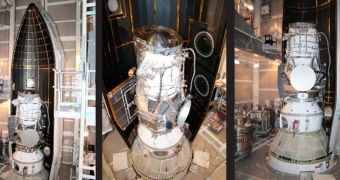According to officials at the NASA Jet Propulsion Laboratory (JPL), the space agency's new Wide-Field Infrared Survey Explorer (WISE) satellite has just been fitted inside its nose fairing. The device will protect the sensitive, infrared-wavelength telescope as it makes its way to the Earth's orbit. The scheduled launch data is December 9. The observatory is scheduled to be launched aboard a Delta II rocket, from the Vandenberg Air Force Base, in California. The new spacecraft builds on successful designs for the NEXTSat missions.
Mission controllers say that the ship's payload will consist of about 560 kilograms (about 1,175 pounds) of scientific equipment. The main instrument will be a 40-centimeter (16-inch) diameter infrared-sensitive telescope, which will be used to scan and make maps of the Universe at specific wavelengths, of three and 25 micrometers. NASA engineers reveal that WISE carries devices capable of producing infrared images that are up to 1,000 times more sensitive than the ones carried to orbit by previous, similar explorers such as IRAS, AKARI and COBE.
The new stage, which was completed only a couple of days ago, marks another important step in the preparation process. The fairing is scheduled to separate like a clam about five minutes after launch, after which time the new telescope will be directly exposed to the orbital medium. Plans have it that the observatory will circle the Earth over its poles, and use its nine-month mission time to scan the Universe completely one and a half times. Cool stars and dark asteroids are among the main targets of these observations, but features such as the brightest galaxies would also be imaged, scientists say.
Other observatories, including NASA's Hubble and Spitzer Space Telescopes, the European Space Agency's (ESA) Herschel Space Observatory, and NASA's upcoming Sofia and James Webb Space Telescope, will follow up on WISE's finds. The new instrument will map the entire sky using four infrared wavelengths, the American space agency reports. “With infrared, we can find the dark asteroids other surveys have missed and learn about the whole population. Are they mostly big, small, fluffy or hard?” JPL Wise project scientist Peter Eisenhardt says.
“Wise is chilled out. We've finished freezing the hydrogen that fills two tanks surrounding the science instrument. We're ready to explore the universe in infrared,” JPL Project Manager William Irace adds. He explains that, in order to be effective, WISE's instruments will be cooled almost to absolute zero. The coldest of these devices will operate at about eight degrees Kelvin, or minus 445 degrees Fahrenheit.
The California Institute of Technology (Caltech)-based JPL manages WISE for NASA's Science Mission Directorate, in Washington DC. Edward Wright, from the University of California in Los Angeles (UCLA), is the principal investigator. The mission was competitively selected under NASA's Explorers Program managed by the Goddard Space Flight Center, in Greenbelt, Maryland.

 14 DAY TRIAL //
14 DAY TRIAL //